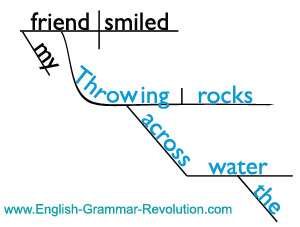Participle Phrases
Participles are words that look like verbs and act like adjectives.A participle phrase consists of a participle and its accompanying words.

Words that are made of verbs but don't act like verbs are called verbals. There are two other kinds of verbals: gerunds and infinitives.
Participles
They end in -ing, -d, -t, or -n.
Quick Refresher: Adjectives are words that describe nouns and pronouns.
Here are some examples. Notice that each one is made of a verb but is modifying a noun.
frozen food (froze = verb)
burned toast (burn = verb)
Since these guys act as adjectives, they are diagrammed in a very similar way to how adjectives are diagrammed.
It's easy to see that they modify nouns and pronouns because they are diagrammed on a slanted, curved line underneath the noun or pronoun that they modify.

Participial Phrases
Participial phrases consist of a participle along with all of its modifiers and complements.
Here are three examples. Notice that each phrase is modifying a noun.
Example 1
- The participial phrase is crying in the night.
- It modifies the noun babies.
- The participial phrase is frozen for over five years.
- It is modifies the noun food.
- The participial phrase is burned on each side.
- It modifies the noun toast.
Diagramming Participial Phrases
You already know that you diagram it by putting it on curved, slanted line under the noun that it modifies.
After that, find out what the rest of the phrase consists of and diagram it accordingly.
I'll walk you through the steps using this sentence:
- Step 1: Find the participle. (filled)
- Step 2: Find the noun that it modifies. (shoe)
- Step 3: Find the rest of the phrase. (with mud)
- Step 4: Figure out what the rest of the phrase is doing. This is where your other grammar knowledge comes into play. In order to diagram this, you need to know that with mud is a prepositional phrase.
This prepositional phrase is modifying filled. That means that we diagram the prepositional phrase underneath filled.
Check it out:

1. Working in the lab, the scientist created a robot.
2. Early films were still pictures projected on a wall.
3. Moving pictures came later.
4. Food sealed in cans was given to the campers.
5. Quickly frozen food is necessary to preserve the freshness.
6. Coming into the room, the boy threw his books on the desk.
7. Joe, searching for the code, was really excited.
8. The store sold packaged bakery.
9. Pork and beans canned in tomato sauce is my favorite.
10. Relaxing on his back patio, Jeff fell asleep.
2. Early films were still pictures projected on a wall.
3. Moving pictures came later.
4. Food sealed in cans was given to the campers.
5. Quickly frozen food is necessary to preserve the freshness.
6. Coming into the room, the boy threw his books on the desk.
7. Joe, searching for the code, was really excited.
8. The store sold packaged bakery.
9. Pork and beans canned in tomato sauce is my favorite.
10. Relaxing on his back patio, Jeff fell asleep.
Sources:
http://www.english-grammar-revolution.com/participles.html
http://members.cox.net/lenco1/grammarpractice/participle/phrase.htm









2 komentar:
Excellent explanation.Thanks a bunch, it helped me a lot.This is one of the best blogs I have ever read. I was not expecting that I'd get so much out of reading your write up.Extremely helpful article to understand the types of sentences in an easier way.Keep it up the good work.
Thanks a lot
Post a Comment